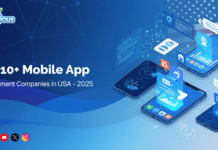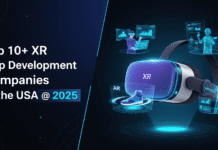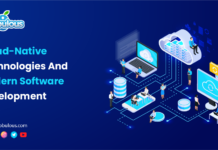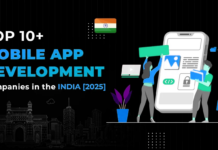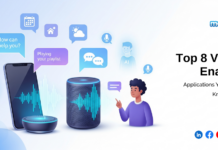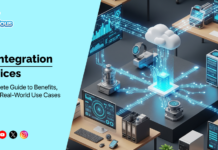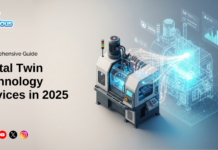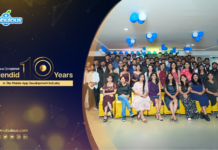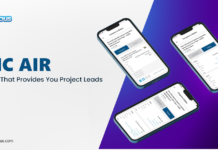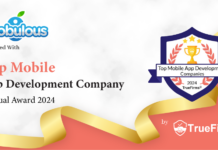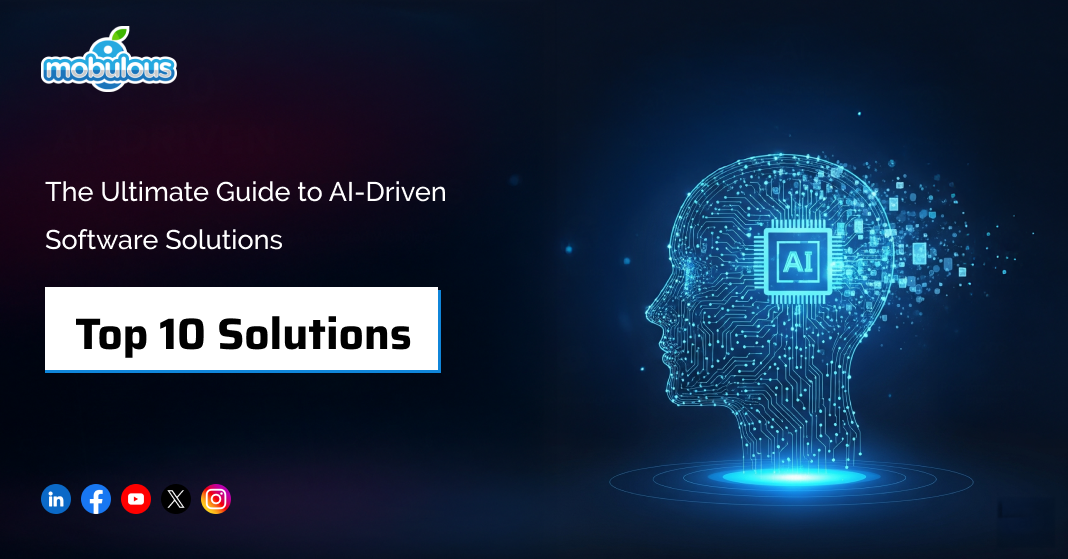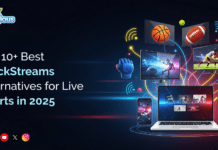Guide to AI-Driven Software Solutions: Benefits, Challenges & Trends
An AI-driven software solution is a smart application powered by machine learning, deep learning, and natural language processing, mimicking human intelligence. It automates tasks, extracts insights, and assists with decisions to make business work faster, smarter, and more personalized.
Benefits of AI-Driven Software Solutions
1. Increased Efficiency and Productivity
AI-driven tools reduce the need for manual work, as they handle tasks like data entry and customer support automatically, helping employees focus on more strategic roles. The result is faster task completion and higher output. Many AI software providers offer tools that significantly improve business productivity.
2. Enhanced Accuracy and Reduced Errors
AI systems are designed to minimize human error by detecting and correcting mistakes in real time. This is especially useful in sensitive industries like healthcare and finance. AI models improve in accuracy with time, resulting in greater precision and reliability.
3. Cost Savings
AI helps reduce labor and operational costs. For example, AI chatbots cut the need for large customer support teams. Predictive maintenance tools prevent costly breakdowns, and these savings grow over time, making AI solutions a valuable investment for companies of all sizes.
4. Improved Customer Experience
AI improves how businesses interact with customers, and tools like chatbots and recommendation engines offer fast and personalized service. Customers get accurate answers and relevant suggestions, leading to better satisfaction and higher loyalty. AI solutions providers now focus heavily on enhancing customer experiences.
5. Data-Driven Insights and Decision Making
AI turns complex data into easy-to-understand insights, helping predict trends and track customer behavior. With these insights, businesses make smarter decisions. Real-time dashboards are common features in AI solutions, acting like digital advisors for decision-makers.
6. Enhanced Security
AI tools monitor for unusual activity all the time, quickly identifying threats, taking action, and keeping systems safe from hackers and data breaches. Cybersecurity AI learns from past threats to prevent new ones. Some free AI tools even offer these features.
Challenges of AI-driven Software Solutions
1. AI Ethical Issues
AI models can reflect bias found in their training data, leading to unfair outcomes. Also, there’s concern about AI replacing jobs. Many experts call for ethical guidelines. AI solutions providers must build fairness into their tools as responsible AI is now in growing demand.
2. Data Privacy
AI needs a lot of data to work well, raising concerns about how that data is used and stored. Laws like the General Data Protection Regulation (GDPR) protect user information. Companies must make sure their AI tools follow these rules, as poor handling of data can lead to big fines and lost trust.
3. AI Transparency
Some AI systems act like “black boxes,” and it’s hard to see how they make decisions. This is a problem in areas like law and healthcare. More companies now offer explainable AI, showing how decisions are made and helping build user trust.
4. Bias in AI
AI systems can be biased, and this happens when the training data lacks diversity. For example, facial recognition may not work equally well for all groups. Businesses must check for bias regularly, as AI solutions providers are starting to use tools to audit and fix these issues.
5. AI Integration
Bringing AI into existing systems can be tough, as old software and poor data quality make things harder. Businesses often lack the right skills to manage this change. Pilot testing helps ease this process, ensuring the tool works before full adoption.
How to Choose the Right AI-Driven Software Solutions
1. Identify Business Needs and Use Cases
Start by identifying your business challenges, like asking yourself what tasks need automation or data analysis. With clear goals, you can find the right AI tool. AI solutions for business work best when matched to specific problems, saving time and effort.
2. Evaluate Solution Features and Capabilities
List out what you need from the software, including data analytics, chatbots, or prediction models. Make sure the tool fits your current systems, as some tools offer more features than others. AI solutions with the right capabilities bring more value over time.
3. Cost Analysis
Look beyond the basic price, including costs like training, setup, and future updates. Compare multiple vendors, as some even appear on the free AI tools list. Choose tools that offer the best value, not just the lowest price. A full cost breakdown prevents budget surprises.
4. Consider Data Privacy and Security
Security should be a priority from the start, so make sure the tool uses encryption and complies with data laws. Choose companies that are transparent about how they handle data. Trusted AI software protects your information and your reputation.
5. Pilot Testing and Proof of Concept
Try the software in a small area before going big. This is called a proof of concept, showing if the tool fits your needs and monitoring how it performs. Many AI providers offer free trials or demos, so testing saves you from costly mistakes later.
6. Assess Scalability and Flexibility
Choose software that grows with your business, as if data increases, and the tool should be able to handle more tasks. Look for flexible platforms with modular features. The following top 10 AI tools often support both small and large businesses, adapting to different industries and needs.
Top 10 AI-Driven Software Solutions
Here are 10 AI-driven software solutions making waves in 2025, categorized by their primary function:
General AI Platforms:
- IBM Watson
- Microsoft Azure AI
- Google Cloud AI
Machine Learning & Data Analysis:
- H2O.ai
- DataRobot
- Databricks
Customer Engagement:
- Salesforce Einstein
- ChatGPT
Automation:
- UiPath
- Amazon SageMaker
These tools are among the top 10 AI tools, and leading companies offer many. Some also appear in the free AI tools list, depending on usage tiers.
Future Trends in AI-driven Software Solutions
AI software is evolving quickly as we now see tools that better understand human intent, allowing smoother communication between people and machines. AI also powers smarter testing tools and security features, leading to safer and faster development.
Hyper-personalization is another trend, as tools learn what users want and offer tailored experiences. AI is also helping with big business decisions, and soon, more companies will rely on AI for everyday tasks. The best AI solutions for business will be those that are smart, fast, and easy to use.
Conclusion
AI-driven software is reshaping the future by boosting efficiency, improving accuracy, and reducing costs. Businesses now use AI for everything from marketing to cybersecurity, but success depends on choosing the right tool.
Understand your needs first, then explore tools that offer the best mix of features, flexibility, and security. Whether you use a major AI software or start with a free AI tool, the time to act is now. Smart AI adoption means staying ahead in a fast-changing world.
FAQs – AI-Driven Software Solutions
Q1. What are some examples of AI-driven software solutions?
Ans. AI is used in many tools, such as Siri, Alexa, and self-driving cars, to help with fraud detection and shopping suggestions. Chatbots use AI to answer customer questions, powering facial recognition and medical tools. These solutions help businesses work smarter and serve customers better.
Q2. Do AI-driven software solutions require constant human intervention?
Ans. AI can do many tasks independently, but it still needs human support. People are needed for setup, training, and updates. AI also needs help when problems happen. It cannot handle every situation, which is why humans make sure the AI works well and stays accurate over time.
Q3. What industries can benefit from AI-driven software?
Ans. Many industries use AI to improve their work; for example, healthcare uses it for faster diagnoses, finance uses it to detect fraud, retail and manufacturing use it to manage operations, and transportation uses it for smart routing. These tools save time, reduce costs, and help companies grow.
Q4. What are the top AI software solutions for small businesses?
Ans. Small businesses use AI for many tasks, like Salesforce Einstein and Zoho CRM help with sales, Jasper writes content, Veed makes videos, Monday.com manages projects, and Zapier and Reclaim.ai automate daily work. These tools save time and boost productivity, and they are easy to use and affordable, too.
Q5. What are the most popular AI software solutions in 2025?
Ans. In 2025, popular AI tools include ChatGPT, Claude, and Gemini, which are widely used for conversations; Midjourney and Photoshop, which help with images; and Jasper and Taskade, which are for boosting productivity. These tools help with work, creativity, and daily tasks across different fields.
Q6. What is the cost of AI-driven software solutions?
Ans. AI software can be cheap or expensive, whereas some tools are free or low-cost, and custom systems may cost $50,000 to $500,000 or more. Prices depend on features and size, which means smaller tools are good for startups and bigger tools are built for large companies. So choose based on your needs.
Q7. Can AI-Driven Software Solutions be scaled for large organizations?
Ans. Yes, AI software can scale easily; it can handle more users and data, growing as the business grows. Large companies use AI to manage work faster and stay reliable even under pressure. Hence, AI is key to growth and long-term success in big firms.
Q8. What are the risks of using AI software in business?
Ans. AI comes with some risks, including cyberattacks, privacy issues, and biased choices. Some jobs may change or disappear. Businesses must watch AI closely, follow the rules, and act responsibly. The safe use of AI helps avoid harm and builds trust.
Q9. What is pilot testing for AI software, and why is it important?
Ans. Pilot testing means trying AI on a small scale first, helping find errors and fixing them. It shows if the AI fits business needs, saves time and money, and lowers risk. Businesses use pilot tests before full rollout to ensure the AI works well.
Q10. What is the difference between AI-driven software and traditional software?
Ans. AI software learns from data and changes over time, while traditional software follows fixed rules. It stays the same unless someone updates it. AI can improve itself with use, making it smarter and more flexible. This learning ability is what sets AI apart from regular software.

